Use 'Print preview' to check the number of pages and printer settings.
Print functionality varies between browsers.
Printable page generated Wednesday, 8 May 2024, 11:00 PM
Unit 6: Food & Drink
Introduction
In this unit we look at the role of the Scots language in an important area of Scottish life and in Scotland’s economy. Food and drink make up the largest sector of Scottish exports and this very successful industry employs almost 1 in 5 (18.8%) of all workers, most of them in small local businesses (Gates, 5 top exports for Scotland right now, 2017).
You will learn about traditional Scottish fare; food and drink which are created from produce grown or sourced in Scotland. Not surprisingly, it is largely the geography of the country, its rugged hills and cool, damp climate that have determined the crops which can be grown and the animals which can be reared.
With just under 17,000 km of coastline, it is equally unsurprising that seafood features prominently on our menus. Scotland’s food and drink are celebrated so vibrantly in the nation’s literature and folk culture that there are references throughout to examples of these. Consideration of such examples will raise your awareness of Scotland’s culture and attitudes to Scottish staple foods and drinks.
Two books have defined the nature of Scottish cookery for several generations of consumers: The Meg Dods Cookery Book by Margaret Dods (1823) and The Scots Kitchen, Its lore and recipes by F. Marian McNeill (1929).
However, with increased availability of international ingredients, you may consider there is now no such thing as distinctive Scottish fare. Yet, on the other hand, you may well believe that the traditional Scots kitchen is undergoing a gastronomic revolution.
Important details to take notes on throughout this unit:
- The influence of geography on the production of Scottish food and drink
- Food and drink: their role in Scottish culture
- The Scottish eating and drinking habits and the nation’s health
- A gastronomic trend.
Activity 1 
Before commencing your study of this unit, you may wish to jot down some thoughts on any of the four important details we suggest you take notes on throughout this unit. You could write down what you already know about each/any of these four points, as well as any assumption or question you might have. You will revisit these initial thoughts again when you come to the end of the unit.
6. Introductory handsel
A Scots word and example sentence to learn:
- Spurtle
- Definition: A short, round stick used for stirring porridge, soup, etc.
- Example sentence: “The meall is steired wi a spurtle tae mak parritch.”
- English translation: “The oatmeal is stirred with a spurtle to make porridge.”
Please note: In Scots, meall always refers to oatmeal, as opposed to pease-meal or barley meal.
Activity 2
Click to hear the sentence above read by a Scots speaker.
You can then make your own recording and play it back to check your pronunciation.
Transcript
Listen
The meall is steired wi a spurtle tae mak parritch.
Model
The meall is steired wi a spurtle tae mak parritch.
Go to the Dictionary of the Scots Language for a full definition of the word

Related word:
- Kail
- Definition: Borecole, esp. the curly variety; by extension, a main meal or dinner.
- Example sentence: I hope, Sir Andrew, ye'll no objek to tak your kail wi' us.
- English translation: I hope, Sir Andrew, you won’t object to taking your meal with us.
Please note: With Scotland’s relatively mild winters, kail was the staple vegetable, grown almost everywhere and used in broths as well as cooked in various other ways. As its main use was in soup, the word kail often referred to any kind of soup or even to a meal.
Activity 3
Click to hear the sentence above read by a Scots speaker.
You can then make your own recording and play it back to check your pronunciation.
Transcript
Listen
I hope, Sir Andrew, ye'll no objek to tak your kail wi' us.
Model
I hope, Sir Andrew, ye'll no objek to tak your kail wi' us.
Go to the Dictionary of the Scots Language for a full definition of the word
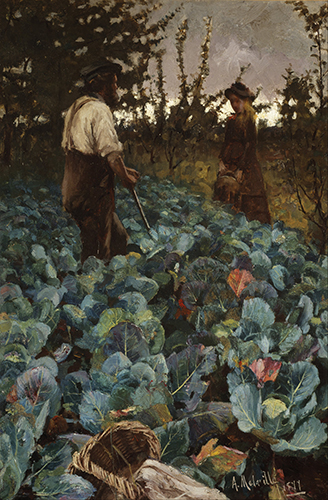
6.1 Traditional foods
Kail, haggis, neeps an tatties
Activity 4
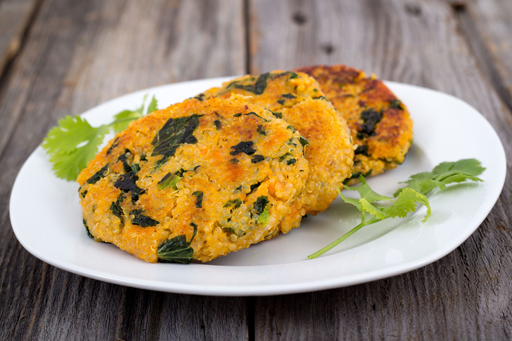
In recent years, kail, a form of brassica, has become a fashionable vegetable. Here is a picture of some ‘posh nosh’: sweet potato, kail and quinoa fritters with crème fraiche for dunking.
Read this information and take notes on the climatic factors favouring the growing of kail.
Please note: The usual spelling in Scotland is kail, but “kale” is also often used.
Cold-hardy and resilient, kale is an easy member of the cabbage family to grow. You can set out plants quite early in spring as long as you protect the young plants from severe cold winds with a cover. They will grow steadily for months until the weather gets too warm. You’ll get a second chance to plant kale in the fall, when cool weather brings out a wonderfully sweet, nutty flavour that is unique to these cold-natured plants.
Fall is the best time for growing kale in areas where winter doesn’t dip below the teens, or in a cold frame farther north, because the leaves are sweeter when they mature in cooler weather. In the kitchen, kale can be steamed, stir-fried, or substituted for spinach in omelets, casseroles, or even quesadillas. It’s a wonderful addition to smoothies, too.
(Bonnie Plants, Growing Kale)
Answer
Kail or kale is a vegetable that thrives in cooler conditions. However, when it gets too cold and windy, or too hot, the plants won’t grow or even survive. Autumn is the best time for growing sweet-tasting kail, but in areas where temperatures infrequently dip below 10˚C kail can grow throughout the winter.
This is an ideal nutritious vegetable for Scotland’s temperate climate with an average temperature ranging from 17˚C in the summer and 5˚C in the winter.
Neeps and tatties (turnips and potatoes) are most famously served champit (mashed) as an accompaniment to haggis at Burns Suppers. Haggis was essentially the food of the poor cottar farmers who had to sell most of their animals in the autumn as they could not grow enough to feed themselves as well as provide fodder to winter their beasts.
Hence, the perishable offal (heart, liver, lungs) was minced and mixed with oatmeal, spices, suet and seasoning, then stuffed in the animal’s stomach. If you would like to make a haggis from scratch, consult Meg Dod’s cookery book!
No one knows where haggis originated, but it has – largely thanks to Burns’ poem – become Scotland’s national ‘delicacy’. Great respect is shown to it at Burns’ Suppers, as befits a dish which has all the life-enhancing qualities the poem describes! During the address to a haggis as part of the Burns Supper ceremony, the reciter plunges the knife in the haggis then pours a dram of whisky into ‘the entrails’.
Activity 5
Part 2
Now read the entire poem and its translation and compare both with your notes from Part 1 of this activity.
| Address to a Haggis | Address to a Haggis Translation |
|---|---|
| Fair fa' your honest, sonsie face, Great chieftain o the puddin'-race! Aboon them a' ye tak your place, Painch, tripe, or thairm: Weel are ye worthy o' a grace As lang's my arm. | Good luck to you and your honest, plump face, Great chieftain of the sausage race! Above them all you take your place, Stomach, tripe, or intestines: Well are you worthy of a grace As long as my arm. |
| The groaning trencher there ye fill, Your hurdies like a distant hill, Your pin wad help to mend a mill In time o need, While thro your pores the dews distil Like amber bead. | The groaning trencher there you fill, Your buttocks like a distant hill, Your pin would help to mend a mill In time of need, While through your pores the dews distill Like amber bead. |
| His knife see rustic Labour dight, An cut you up wi ready slight, Trenching your gushing entrails bright, Like onie ditch; And then, O what a glorious sight, Warm-reekin, rich! | His knife see rustic Labour wipe, And cut you up with ready slight, Trenching your gushing entrails bright, Like any ditch; And then, O what a glorious sight, Warm steaming, rich! |
| Then, horn for horn, they stretch an strive: Deil tak the hindmost, on they drive, Till a' their weel-swall'd kytes belyve Are bent like drums; The auld Guidman, maist like to rive, 'Bethankit' hums. | Then spoon for spoon, the stretch and strive: Devil take the hindmost, on they drive, Till all their well swollen bellies by-and-by Are bent like drums; Then old head of the table, most like to burst, 'The grace!' hums. |
| Is there that owre his French ragout, Or olio that wad staw a sow, Or fricassee wad mak her spew Wi perfect scunner, Looks down wi sneering, scornfu view On sic a dinner? | Is there that over his French ragout, Or olio that would sicken a sow, Or fricassee would make her vomit With perfect disgust, Looks down with sneering, scornful view On such a dinner? |
| Poor devil! see him owre his trash, As feckless as a wither'd rash, His spindle shank a guid whip-lash, His nieve a nit; Thro bloody flood or field to dash, O how unfit! | Poor devil! see him over his trash, As feeble as a withered rush, His thin legs a good whip-lash, His fist a nut; Through bloody flood or field to dash, O how unfit. |
| But mark the Rustic, haggis-fed, The trembling earth resounds his tread, Clap in his walie nieve a blade, He'll make it whissle; An legs an arms, an heads will sned, Like taps o thrissle. | But mark the Rustic, haggis-fed, The trembling earth resounds his tread, Clap in his ample fist a blade, He'll make it whistle; And legs, and arms, and heads will cut off Like the heads of thistles. |
| Ye Pow'rs, wha mak mankind your care, And dish them out their bill o fare, Auld Scotland wants nae skinking ware That jaups in luggies: But, if ye wish her gratefu prayer, Gie her a Haggis | You powers, who make mankind your care, And dish them out their bill of fare, Old Scotland wants no watery stuff, That splashes in small wooden dishes; But if you wish her grateful prayer, Give her [Scotland] a Haggis! |
Part 3
And now you have the opportunity to practice your spoken Scots. Read out the first verse of Burns’ poem and record yourself doing so. Then compare your reading with our model as well as the spoken version from a Burns supper presented in the video on the Scottish poetry website . Repeat this activity step until you are satisfied with your pronunciation of Burns’ poem.
Transcript
Listen
Fair fa' your honest, sonsie face,
Great chieftain o' the puddin-race!
Aboon them a' ye tak your place,
Painch, tripe, or thairm:
Weel are ye worthy o a grace
As lang's my airm.
Model
Fair fa' your honest, sonsie face,
Great chieftain o' the puddin-race!
Aboon them a' ye tak your place,
Painch, tripe, or thairm:
Weel are ye worthy o a grace
As lang's my airm.
Part 4 
In this final step we want to draw your attention to the fact that what many consider the Scottish national dish is not always approved of in other cultures. As an example, read this article on the BBC Scotland news page to find out why haggis was banned in the United States despite repeated efforts by the Scottish Government to overturn the ban.
Beef and lamb
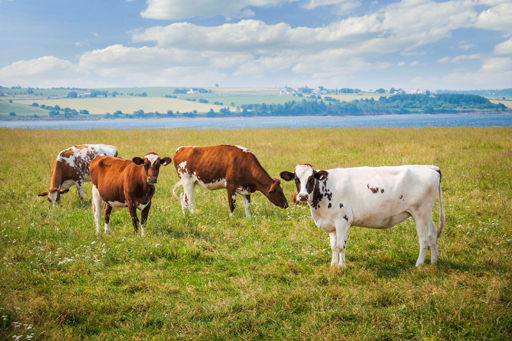
In June 2016, Scotland had 6.8 million sheep and 5.3 million people. Sheep thrive on the short rough grass of the hills, while the longer juicier grass which grows in the wetter west supports large numbers of dairy cattle, like the Ayrshire cow.
In the past, pigs were fed on the skimmed milk and buttermilk which were by-products of the dairy industry. This made the western county of Ayrshire famous for its bacon. The famous black Aberdeen-Angus and Galloway cattle are known throughout the world as a source of prime beef.
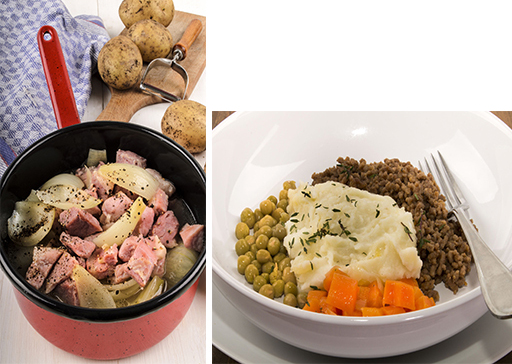
Stovies and ‘mince an tatties’ are perhaps Scotland’s best loved comfort foods and the ingredients in both dishes are basically the same: minced beef, onions, carrots, potatoes. However, the tatties are usually champit in the latter dish, whereas in stovies, which are are usually made from left-over meat or mince, gravy and tatties are added to complete this dish that is cooked with all ingredients in one bowl or pot.
Activity 6 
We live in an age of globalisation, which in cooking and gastronomy often results in culinary fusions. Later on in this unit you will engage in some more detail with this aspect of Scotland’s culinary revolution. To prepare your engagement with this, we would like you to consider what determines what and how people eat in a particular culture. You will comment on the statement by Marian McNeill below.
‘…however plentiful and varied the imported foodstuffs, it is the natural conditions and products that determine the general character of the national cuisine.’
Considering what you have learned so far, do you agree with Marian McNeill’s statement, even at the age of globalisation? Note briefly the geographical and any other factors which have resulted in Scotland’s best known traditional food and drink and whether you think that these traditional foods might change through external influences.
Answer
This is a model answer. Your notes might be different.
Marian McNeill’s statement can hardly be disputed. The mountainous parts of Scotland support 6.8 million sheep that thrive on the short wiry grass and can survive cold weather, while the low-lying areas are used to rear cattle and grow crops. The heavy rainfall on the west encourages long grass for dairy cows and mild winters allow an extended grazing period.
The climate is too cool for wheat, but oats and barley have been grown for centuries, especially in the drier sunnier east. Fishing is also of great importance along Scotland’s 17,000 km of coastline. Haggis, perhaps Scotland’s most famous traditional dish, was originally a peasant food invented to use up the perishable parts of the sheep and cattle which had to be slaughtered before winter set in.
In my view the core of the Scottish cuisine will not change despite culinary influences from abroad, changes to the way food is produced and supplied and to how people cook and eat. The Scottish climate also has an impact on the kinds of food people want to eat.
For example, I believe that in winter people in Scotland will always want the foods we label ‘comfort food’ – the climate is relatively cold, the weather often harsh and people crave food that provides them with enough calories to keep up their body temperature.
Fantoosh Fusion…from Oat to Haute cuisine
You have come across the word Fantoosh in the unit Scots today. In the context of this unit, the word is used to describe something flashy, showy or ultra-fashionable, namely Scottish cuisine as a modern culinary trend. The Taste of Scotland website confirms that Scotland due to its rich and varied food resources can develop a worldwide reputation:
‘If Scotland’s chefs can continue to serve up the finest and freshest seasonal Scottish ingredients, showcasing Scotland’s larder of artisan and native foods, enhanced with a gourmet spin, flair and passion then Scotland will be able to take its place as a world class food destination’.
Traditional foods like kale or haggis have been given a new look by modern chefs. In recent years, international chefs have recognised the quality of Scottish fare and ‘A Taste of Scotland’ has encouraged those at home to experiment using Scottish ingredients.
Fusion Cuisine 
You can find out more about current trends in Scottish fusion cuisine on the Taste of Scotland website. Here you can discover some of the esoteric dishes that are the product of the culinary fusions tried out by modern chefs which feature Scottish ingredients.
In 2007, the Scotland Food and Drink Partnership was formed. Within a decade of this, the Food and Drink industry’s turnover increased by 44%. In March 2017, Ambition 2030 was launched to build up Scotland’s reputation as a ‘Land of Food and Drink’ and to promote Scottish food locally and globally.
6.2 Drink
In this section, you will become familiar with all kinds of traditional Scottish drinks, from water to whisky. From learning new words and studying some quotations about drinking, you will be able to form an opinion on the attitude of the Scots towards various beverages.
The water of life
In 2017, ‘Whisky accounted for over 20% of all UK food and drink exports. There was further growth in exports of Single Malt Scotch Whisky, growing by 14.2% in 2017 to £1.17bn’ (Scotch Whisky Association, 2018).
Single malt whisky, mostly made in the Highlands, has to be made at one distillery, from malted barley, and matured for at least three years in traditional casks. ‘Malted’ means the barley is steeped in water then spread out until it germinates, after which the barley is dried out in a kiln.
In the western islands, the kilns are fired with peat. This along with the peaty water gives island malts a peaty, smoky flavour. Malt whiskies from Speyside are not smoky. Ordinary whisky is sometimes called grain whisky as it is made from a mixture of barley and other cereals, like wheat or maize.
Whisky has always played an important role in Scottish life and culture; a dram (an informal name for a small amount of an alcoholic drink, especially whisky) will be taken to calm a troubled spirit, seal a bargain, make a toast, cure a cold, steady the nerves, or celebrate special events. For this reason, it is hugely celebrated in Scottish literature and song.
Again, the national bard, Robert Burns, produced poetry that even finds Biblical justification for alcohol. For example, he began his poem Scotch Drink with a poetic rendering of Proverbs Ch 31, verses 6 and 7 from the Bible:
Verse 6: Give strong drink unto him that is ready to perish; and wine unto those that be of heavy hearts.
Verse 7: Let him drink, and forget his poverty, and remember his misery no more.
This is Burns’ adaptation in his 1785 poem:
| Gie him strong drink until he wink, That's sinking in despair; An' liquor guid to fire his bluid, That's prest wi' grief an' care: There let him bouse, and deep carouse, Wi' bumpers flowing o'er, Till he forgets his loves or debts, An' minds his griefs no more. |
Activity 7
In this activity you will be working with Burn’s poem ‘Scotch Drink’ in some more detail and practise speaking Scots again.
Part 2
Now listen to the first verse of 'Scotch Drink' and record yourself reading it out loud. Then compare your own version with our model.
Transcript
Listen
Gie him strong drink until he wink,
That's sinking in despair;
An' liquor guid to fire his bluid,
That's prest wi' grief an' care:
There let him bouse, and deep carouse,
Wi' bumpers flowing o'er,
Till he forgets his loves or debts,
An' minds his griefs no more.
Model
Gie him strong drink until he wink,
That's sinking in despair;
An' liquor guid to fire his bluid,
That's prest wi' grief an' care:
There let him bouse, and deep carouse,
Wi' bumpers flowing o'er,
Till he forgets his loves or debts,
An' minds his griefs no more.
Uisge-beatha is the Gaelic word from which the word whisky is derived, usquabae the Scots equivalent of the Gaelic. It means literally ‘water of life’. Here is an extract from ‘Tam o’ Shanter’ (1790), another famous Robert Burns poem where drinking alcohol features strongly. It personifies barley as ‘John Barleycorn’ and extolls its ability (when made into beer or whisky) to give you courage. Here an extract outlining how whisky changes people’s perception of reality.
Inspiring bold John Barleycorn!
What dangers thou canst make us scorn!
Wi' tippeny, we fear nae evil;
Wi' usquabae, we'll face the devil!
Please note: tippeny is a thin beer
Single malt whisky, mostly made in the Highlands, has to be made at one distillery, from malted barley, and matured for at least three years in traditional casks. ‘Malted’ means the barley is steeped in water then spread out until it germinates, after which the barley is dried out in a kiln.
In the western islands, the kilns are fired with peat. This along with the peaty water gives island malts a peaty, smoky flavour. Malt whiskies from Speyside are not smoky. Ordinary whisky is sometimes called grain whisky as it is made from a mixture of barley and other cereals, like wheat or maize.
Activity 8
In this activity you will practise speaking Scots once more and also compare the attitude towards drinking alcohol expressed in Burns’ ‘Tam o’ Shanter’ with that articulated in a traditional Scottish toast.
Part 1
Listen to the first four lines of verse 13 of the poem and record yourself reading it out loud. Then compare your own version with our model.
Transcript
Listen
Inspiring bold John Barleycorn!
What dangers thou canst make us scorn!
Wi' tippeny, we fear nae evil;
Wi' usquabae, we'll face the devil!
Model
Inspiring bold John Barleycorn!
What dangers thou canst make us scorn!
Wi' tippeny, we fear nae evil;
Wi' usquabae, we'll face the devil!
Part 2
Here you see a traditional humorous Scottish toast that touches upon the health risks that come with drinking too much alcohol.
You might want to memorise and practise speaking this toast in Scots.
Here’s tae us! Wha’s like us?
Damn few an they’re aw deid!
English Translation:
Here’s to us! Who is like us?
Damn few and they are all dead!
Transcript
Listen
Here’s tae us! Wha’s like us?
Damn few an they’re aw deid!
Model
Here’s tae us! Wha’s like us?
Damn few an they’re aw deid!
![]()
Do you think the attitudes towards drinking alcohol expressed in the two examples here are the same as or different from those voiced in ‘Scotch Drink’? Why?
A hauf an a hauf
You may hear someone asking for this in the pub. It literally means a half and a half. A hauf o whisky means a half gill and a wee hauf a quarter gill; the other hauf refers to a half pint of beer as a chaser. And do note - no Scot would ever ask for a ‘Scotch’!
This folk song, often played when people part company, mentions many haufs! This is the second verse of We're No' Awa' Tae Bide Awa’.
So we had a hauf an' anither hauf,
And then we had anither,
When he got fou' he shouted “Hoo!
It's Carnwath Mill for ever."
To listen to this song being performed, access this recording here.
Activity 9
And finally, you will find out about some Scots words used to describe that someone is drunk. Overindulgence in alcohol can result in a person getting fou (fu) (drunk). Not surprisingly, there are many words and phrases which mean ‘drunk’ in Scots. Here are a few:
- blootert
- steamin
- oot the game
- fou as a puggie / fu as a coo / roarin fu
Two of these words are particularly interesting in terms of their origins.
Research the roots of the words steamin and fou and come up with a short summary of where these words originated.
Answer
a.steamin – ‘noticable reduction in common sense and decision making capacity’; this word has an interesting origin... by the turn of the 20th century, many Glaswegians spent the Glasgow Fair weekend going doon the watter – going down the river Clyde from Glasgow. Many families who could not afford an overnight stay would buy a day trip to Rothesay or the Kyles of Bute. Therefore, the term steamin was used to describe people who had a little too much to drink on the paddle steamer.
Please note: steamin can also be used to express the degree of being drunk, and for that purpose it is combined with other words for being drunk as this example illustrates: ‘his lordship gets them fou, steamin' fou’.
- b.fou or fu – can have two meanings:
- a.is derived from the French word for crazy ‘fou’, in Scots it means a person shows irrational, wild and outlandish behaviour because of having drunk too much alcohol
- b.being full of alcohol
Please note: It is interesting to see that the Oxford Dictionary provides the translation as ‘crazy’ derived from French, whereas the Dictionary of the Scots Language states in the third meaning listed that fou means being ‘full of liquor, drunk, intoxicated’, stating as the origin of the word the English ‘full’.
Where the Oxford Dictionary explains that steamin is one adjective to use in connection with fou to highlight the degree of intoxication, the DSL lists the following adjectives for this purpose: bitch, blin, greetin, roarin, stottin, and tumbling.
6.3 Scran, piece and jeelie piece
In this section you will explore the use of three new Scots words for bread-related food.
- Scran: n. Food in general, especially in odd or miscellaneous pieces, provisions, “grub”; a schoolboy's term for sweet-meats, holiday or picnic provisions.
- Piece: a piece of bread and butter, jam, or the like, a snack, usually of bread, scone or oatcake, a sandwich.
- Jeelie piece: bread and jam; the most common kind of piece in Scotland, often provided as a snack between meals. By extension, a piece came to mean the sandwich lunch carried to work by the working man.
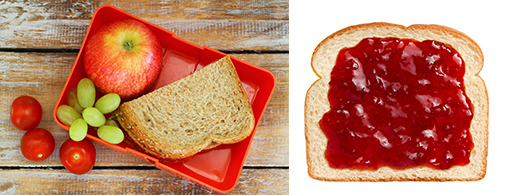
Activity 10
Part 1
If you research the term piece box in the urban dictionary, you will come across this example:
Gaffer (Foreman): "Did ye bring a piece?"
New fella: "Aye, that's mah piece box there"
Practise your spoken Scots by speaking this short dialogue.
Transcript
Listen
Gaffer (Foreman): "Did ye bring a piece?"
New fella: "Aye, that's mah piece box there"
Model
Gaffer (Foreman): "Did ye bring a piece?"
New fella: "Aye, that's mah piece box there"
In parts of Glasgow, mothers would sometimes throw a piece out of the tenement window for a child to catch. When high rise flats were built to replace the 3-storey tenements in the 1950s, this became a little more challenging! The song writer Adam McNaughton produced his response to this in his ‘Jeelie piece sang’ in the 1960s.
Part 2
First of all, find out some more about the word piece for sandwich on the Scots word of the week section of Edinburgh’s Heriot-Watt University. You’ll find the words and translation of McNaughton’s famous song here as well.
Note the reference to bread in the chorus of the song. Here is a picture of Scottish pan bread.

There is no crust on the sides of plain loaves due to the unbaked loaves being stuck together in batches, baked together then torn into individual loaves afterwards; the pan loaf was baked individually in a tin. The pan loaf was more expensive than the plain so that the phrase pan-loaf came to be an adjective describing someone with a posh accent as this extract from Alan Sharp’s novel illustrates.
- ‘“Hello John” He had never quite accustomed himself to Mrs Davidson's voice. It had the classical range of refinements common to the west of Scotland, well-to-do matron, those vowel discolourations and arbitrary emphases known as the 'pan loaf', but instead of the effete bleat that usually accompanied it, with Mrs Davidson there was a hard vigorous timbre ...’
(Sharp, A., A Green Tree in Gedde, 1985)
6.4 Fish
Scotland is part of an island – thus fish is one of its main natural resources. According to the NHS Good Food website, ‘a healthy diet should include at least two portions of fish a week, including one of oily fish’.
Although Scotland is surrounded by water and boasts 8 per cent of Europe’s coastline, a staggering 17,000 km, 70 percent of Scots are not eating this healthy food as often as they should.
A dietician quoted in this article, states that fish should be eaten twice a week. Oily fish like herring, salmon and mackerel, all caught in Scottish waters, provide vitamins, protein and omega 3 which are nutritious and help protect against several serious diseases.
Activity 11 
In contrast to the fact that people in Scotland might not eat enough of this resource, Scottish seafood has developed an international reputation.
Part 1
Watch this video to discover the wide variety as well as the international reputation of Scotland’s seafood.
6.5 Herrin, caller an saut: herring, fresh and salt
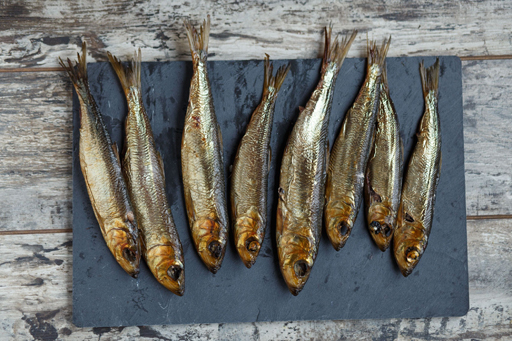
For centuries, herrings, both fresh and salted, were a staple food of Scotland. The growth of the herring industry in north-east Scotland in the 18th century is described by Neil Gunn in his novel The Silver Darlings. Here an extract:
Beginning in May, shoals of herring followed their migratory routes from Stornoway round the north coast, then south to Yarmouth. The catch was landed at the nearest port to be met by an army of merchants, curers and itinerant fisher lasses who gutted the fish and packed it in salt in barrels, for export to Europe and Russia. At the peak of the herring industry in 1907, 2,500,000 barrels ( 250,000 tons) were cured and exported.
Activity 12
As the extract from Gunn’s book states, the peak of herring fishing was reached in 1907. Since then this industry has seen a steady decline. Read the text about Overfishing on HistoryShelf to find out more about the decline of herring fishing in Scotland and note down three important factors in this decline.
Answer
This is a model answer. Your answer might be different.
- Overfishing began in the 1920s which continued for almost 50 years until the stocks were so drastically low that a fishing ban was imposed that lasted for 4 years.
- Markets for cured herring declined as standards of living rose.
- Scotland/the UK joining the European Common Market in 1972 meant that fishing fleets from other nations were entitled to their share of the fish in ‘Scottish’ waters
- Fishing quotas were introduced in the 1970s

Following the decline of the herring fishing, many fishermen turned to catching shellfish, including fresh oysters. While shellfish were in the recent past considered as worthless, they have been a source of food since prehistoric times.
Archaeologists have discovered many Scottish middens (household rubbish dumps) with large quantities of shells buried in them, some dating back to the Stone Age.
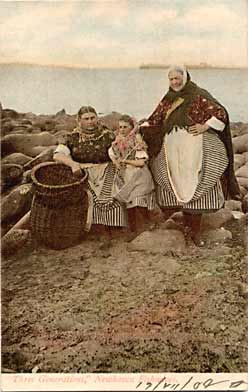
In the 18th century, oysters were a popular food and ‘caller ou’ (fresh oysters) was the cry of the oyster wives as they stood at their stances on Edinburgh streets. Oysters are in season in those months which have an R in them, unlike herring which are in season in the months of May, June, July and August.
They were so popular in Edinburgh that the main taverns in the city were called Oyster taverns. Musselburgh on the Firth of Forth owes its name to the rich shoals of mussels at the mouth of the River Esk. Today, most of the langoustines you see in Spain have been exported from Scotland: Scottish lobsters are exported to Europe and China.
Activity 13
The poet Robert Fergusson (1750-1774) wrote his poem ‘Caller Oysters’ in praise of oysters, celebrating this particular seafood with immense enthusiasm and hyperbole. Not only does he praise their culinary qualities, his hyperbole extends to their alleged medicinal qualities as well.
Listen to the beginning of this poem and try to understand its words. Again, use this as an opportunity to practice your spoken Scots by reading this verse out loud and comparing your version with our model. Finally, read the transcript with our translation.
Transcript
Listen
| Come prie, frail man! For gin thou art sick The oyster is a rare cathartic, As ever doctor patient gart lick To cure his ails; Whether you hae the head or heartache, It ay prevails | Come taste, frail man! For if you are sick The oyster is a great purgative As ever a doctor gave a patient to lick To cure his ails Whether you have the head or heartache It always prevails |
Model
| Come prie, frail man! For gin thou art sick The oyster is a rare cathartic, As ever doctor patient gart lick To cure his ails; Whether you hae the head or heartache, It ay prevails | Come taste, frail man! For if you are sick The oyster is a great purgative As ever a doctor gave a patient to lick To cure his ails Whether you have the head or heartache It always prevails |
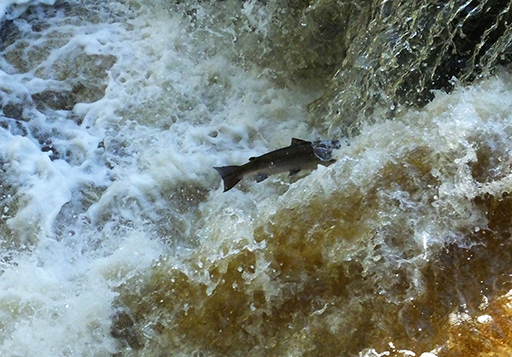
Wild salmon used to be so abundant in our Scottish rivers that it was considered a peasant food and farmhands complained that they were fed so much of it. Atlantic salmon begins life in the rivers of countries bordering the North Atlantic. They migrate to the sea as adults then return, after one to four years, to their native rivers to spawn and produce a new generation.
Our rivers have been so over-fished that most of the salmon we eat now is produced in fish farms. Nevertheless, in 2014, it beat confectionery to become the UK's biggest food export.
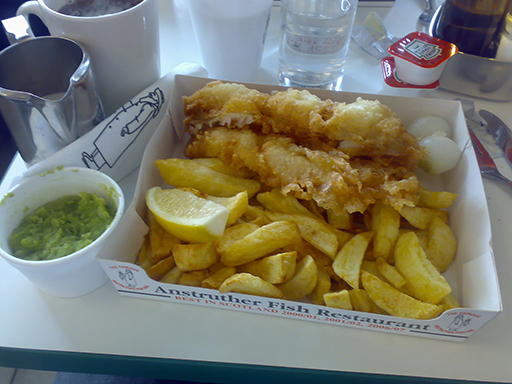
When you are in Scotland, you will hear people talking about having a cairry-oot (also carryout, cerry-oot, carry out, kerry oot, cairy oot) for dinner. This word describes food or alcoholic drink bought in a restaurant, pub, etc. for consumption elsewhere.
And a fish supper is considered by many as Scotland’s most popular take-away food or cairry-oot. It traditionally consists of deep-fried potato chips and haddock; the supper is often wrapped in layers of (news)paper to keep it warm: usually eaten with the fingers – though today a box of some sort and plastic fork is now common.
A recipe in Scots 

And to finish the food and drink unit, here is a fun activity that will hopefully encourage you to get cooking. This time it is another iconic Scottish dish… Cullen Skink. This soup is a local speciality, from the town of Cullen in Moray, on the north-east coast of Scotland.
To add a twist to your cooking experience, we have provided the recipe for the dish in Scots so that you can train your cooking and your Scots language skills at the same time. And just to make sure that your Cullen Skink turns out the way it should, here is an image to show you what it should look like.
Enjoy!
Cullen Skink : a receipt frae the shores o the Moray Firth
Ingredients:
Finnan-haddie, ingans, champit tatties, butter, milk, pepper an saut
- Skin a Finnan-haddie*, an pit it in a pan wi enough watter juist tae cover it (an nae mair).
- Bring it tae the byle an add a chappit ingan.
- Whan the haddie is cuikit, lift it oot an tak oot aw the banes.
- Flake the fish an pit aw the banes back intae the poat.
- Byle for an oor then strain the banes oot an bring it tae the byle again.
- Byle aboot a pint o milk separate an add it tae the stock wi the fish an saut tae taste.
- Byle fur a meenit or twa.
- Add enough champit tatties tae mak the soup guid an creamy
- Add a tablespuinfu o butter wi saut an pepper tae taste.
*Finnan Haddie: a lightly smoked haddock from north-east Scotland
6.6 What I have learned
Activity 14
The final activity of this section is designed to help you review, consolidate and reflect on what you have learned in this unit. You will revisit the key learning points of the unit and the initial thoughts you noted down before commencing your study of it.
Before finishing your work on this unit, please revisit what you worked on in Activity 1, where we asked you to take some notes on what you already knew in relation to the key learning points of the unit.
Compare your notes from before you studied this unit with what you have learned here and add to these notes as you see fit to produce a record of your learning.
Here are the key learning points again for you as a reminder:
- The influence of geography on the production of Scottish food and drink
- Food and drink: their role in Scottish culture
- The Scottish eating and drinking habits and the nation’s health
- A gastronomic trend.
Further research
Listen to this BBC Bitesize clip in which chef Tom Kitchin explains that Scots words are a vital part of his working kitchens. He references Scots dishes and local produce, suggesting that restaurant workers need to be more aware of the Scots words for the food they are preparing.
Learn more about Scotland’s fishing industry.
View a snapshot of Scotland's eating habits.
Gain more information on the manufacture of malt whisky.
Read the Scottish Government's MESAS (Monitoring and Evaluating Scotland's Alcohol Strategy) report.
Try out this recipe for making real ginger beer.
Read an analysis of responses to the consultation on development of a revised national food and drink policy published under the heading Becoming a Good Food Nation in Feb 2015.
The Food and Drink Federation Scotland provides easily accessible statistics about the Scottish Food and Drink industry.
Now go on to Unit 7: Arts and Crafts.
References
Acknowledgements
Every effort has been made to contact copyright holders. If any have been inadvertently overlooked the publishers will be pleased to make the necessary arrangements at the first opportunity.
Grateful acknowledgement is made to the following sources:
Course Image: Supplied by Bruce Eunson / Education Scotland
Activity 2 Image: Burn the asylum. This file is licensed under the Creative Commons Attribution-Share Alike Licence http://creativecommons.org/licenses/by-sa/3.0/
Activity 3 image: Arthur Melville, A Cabbage Garden, National Galleries of Scotland. Purchased with the assistance of the Art Fund, 2007
Activity 4 image: Julie Deshaies/123RF.com
Image on page 10: Elenathewise/123RF.com
Images on page 11: Joerg Beuge/123RF.com
Image on page 19 left graletta/123RF.com
Image on page 19 right Danny Smythe/123RF.com
Activity 10 image: PaylessImages/123RF.com
Image on page 24: tahe4ka/123RF.com
Image on page 25 top: Anna Phillips/123RF.com
Image on page 25 bottom: © peter.stubbs@edinphoto.org.uk
Image on page 26: Pots of Gartness, salmon leaping 02 by byronv2. This file is licensed under the Creative Commons Attribution-Noncommercial Licence http://creativecommons.org/licenses/by-nc/2.0/
Image on page 27 top: www.theedinburghblog.co.uk. This file is licensed under the Creative Commons Attribution Licence http://creativecommons.org/licenses/by/2.0/
Image on page 27 bottom: Cullen skink by Pseph. This file is licensed under the Creative Commons Attribution Licence http://creativecommons.org/licenses/by/2.0/
Text
245974: Extract in Activity 11: Scottish Development International